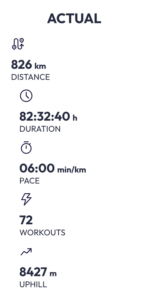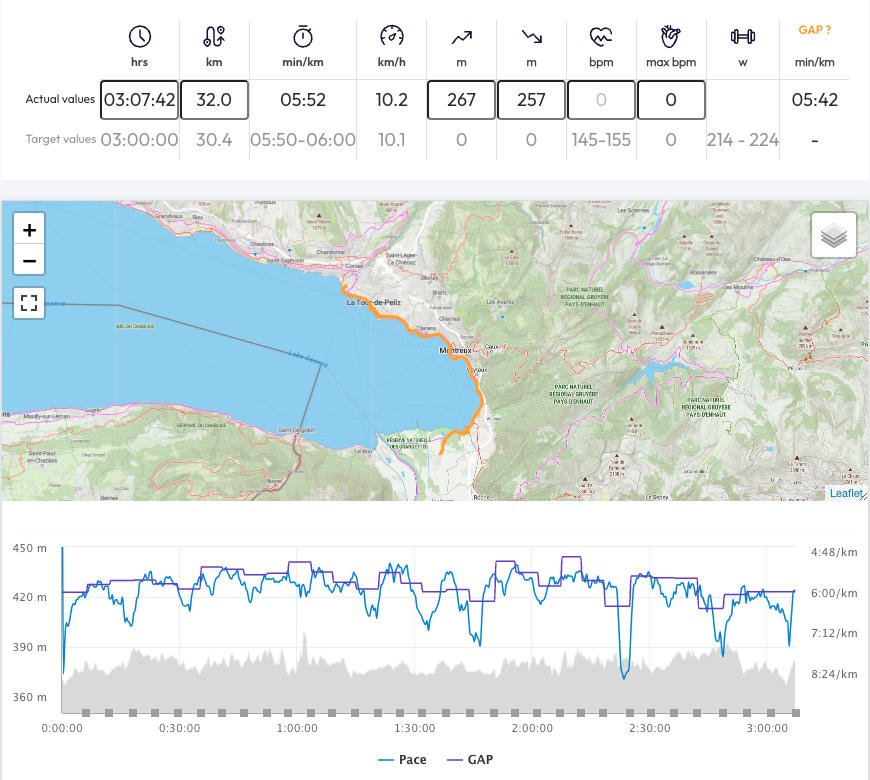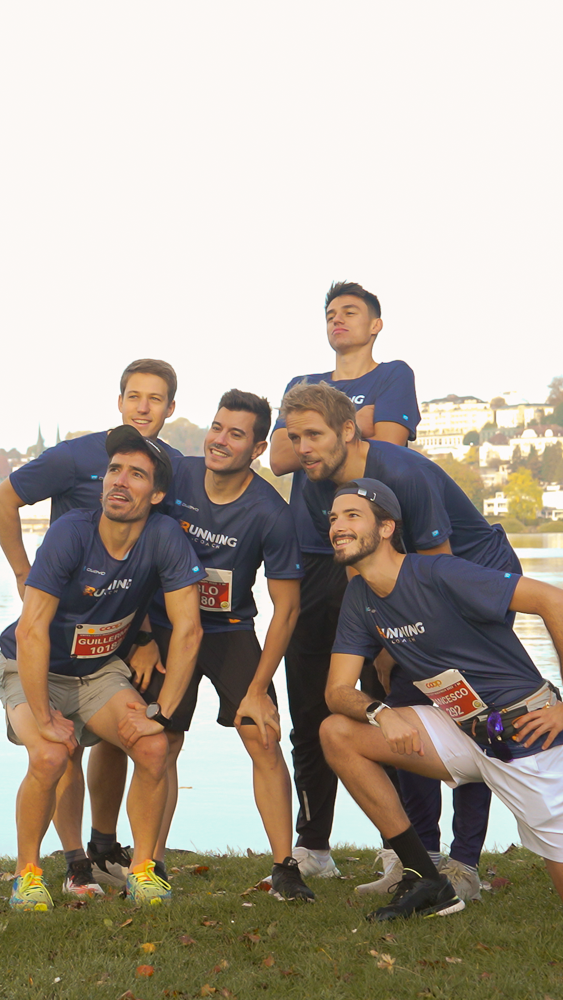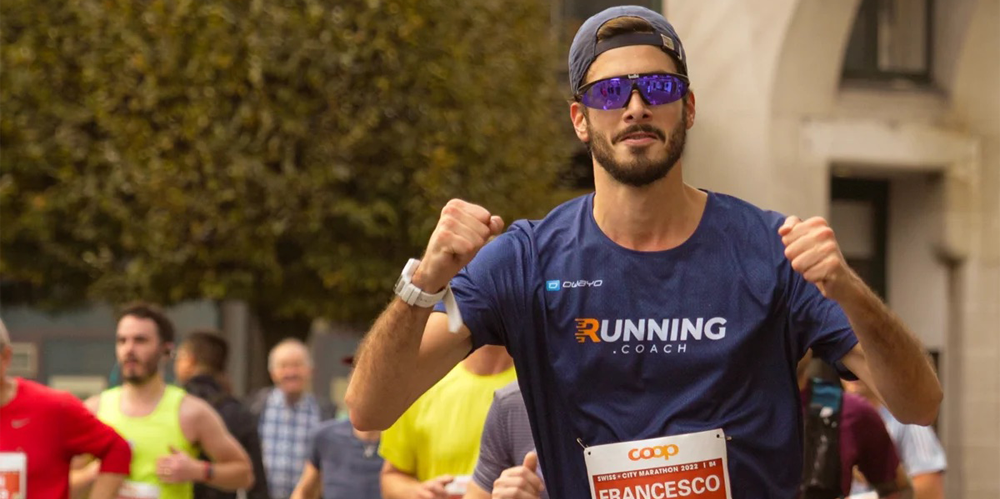How do you go from running 5 km to completing a 42.195 km marathon in 6 months and finishing it in sub 4 hours? Our Community Manager Francesco shares his experience in this article. He reveals his best training tips and discusses the challenges he faced along the way.
Embracing the Challenge: The First Step Towards the Marathon
Four years ago, when I started working for running.COACH, running was simply a way to stay fit, without any competitive ambitions. My weekly runs, usually 5-7 km, were consistent but not aimed at a specific goal. However, thanks to my growing involvement in this world and an increasing passion for running, I progressively raised my training level and became interested in competitions.
The opportunity came in 2022, when the running.COACH team introduced the “annual corporate challenge”: every year, we choose a running competition in Switzerland that becomes our seasonal goal. That year, we opted for the SwissCityMarathon in Lucerne.
At first, I had only opted for the half-marathon. But when I discovered that my only two colleagues who had never tackled a 42 km distance had registered, I felt compelled to challenge myself and raise the bar. So, I decided to go all-in on the marathon, testing at the same time how well the running.COACH training plan works for a less experienced runner.
In the following days, doubts began to haunt me, along with the awareness of the efforts and sacrifices that awaited me in the coming months. It is common to feel overwhelmed and discouraged when facing such a demanding and distant goal. My first advice is not to project too far ahead, but to focus on the present, tackling the challenge week by week through mini-goals.
The Experience of the First Training Sessions
The beginning of the training was challenging because each session was an increase from the previous one. It took time to reach a physical condition that allowed me to manage the fatigue. However, over the weeks, achieving mini-goals became a significant source of motivation for me: running the first 10 km without interruptions, completing the first 10 km in less than an hour, undertaking the first sprints, surpassing the 20 km threshold for the first time, and so on. Every small milestone fueled my determination.
Here is an overview of my training sessions:


Key Points of the Training Path
I would like to share some key aspects of my training that contributed to achieving my goal:
- Consistency: I made maintaining regularity a cornerstone of my journey. Even in the rain, during holidays, or in the summer heat, I always tried not to skip workouts. During the hottest months, I had to adjust the schedule to avoid high temperatures. Although I preferred running before lunch or in the late afternoon, I would get up early to take advantage of the cooler morning hours.
- Following a Plan: Being able to rely on the running.COACH training program was part of my daily routine. The advantage of having a pre-established plan, without worrying about the type of workout or its duration, allowed me to maintain an adequate training volume and avoid injuries. Additionally, seeing the planned trainings on the calendar provided the necessary motivational push in moments when I really didn’t feel like running.
- Variation: Varying the type and intensity of the workouts is crucial in the training process to stimulate the body with different types of stress. During my workouts (three times a week), I focused on distance rather than duration. My typical training week included:
- Monday: Endurance run, aimed at maintaining performance over a prolonged period.
- Wednesday: Intensive run (intervals or tempo run) to work on power, strength, and speed.
- Friday: Long run, the key element of the training week, to improve aerobic performance and endurance and to accustom the body to mechanical stress. The longest run I did with running.COACH was 32 km: we recommend limiting long runs to 3 hours since the additional benefit of longer runs is not proportional to the risk of overload.

- Healthy Lifestyle: I tried to adopt a healthy diet, eliminating junk food and limiting alcohol consumption (completely eliminating it in the last two months).
- Sense of Responsibility and Self-Motivation: The fact that I was so committed to this project, that I dedicated so much time to training, and that I talked about it with family and friends… pushed me to tell myself that I absolutely had to achieve the goal! Although I was aware of the possible complications in the race and that I could not control all the factors involved, this inner encouragement was a great help mentally, especially during the race.
Difficulties Encountered During Preparation
Certainly, it is also important to talk about the difficulties and mistakes encountered along my path:
- Referring back to the first point of the previous list, I must admit that maintaining consistency in training was anything but easy. Especially during the summer, between the heat and holidays, I had to find the strength and motivation to complete (almost) every session.
- I found it challenging to adhere to the pace recommended by running.COACH during low-intensity runs. When I felt fit and capable of running faster, I always tended to maintain a higher pace than scheduled. However, it is important to cover all intensity ranges during training, including low-intensity ones. Running in the lower intensity zones, like zone 1 and zone 2, is crucial because it offers a range of benefits, including active recovery, improving aerobic endurance, and increasing fat-burning efficiency.
- Another mistake I made was neglecting strength training exercises. Some physical pains I experienced could have been avoided if I had spent more time on muscle strengthening.
- Pushing yourself beyond your limits with each training session is a double-edged sword: on one hand, it is a significant source of motivation since every progress is a personal victory; on the other hand, each additional effort requires adequate recovery time, and the body must gradually adapt to such stimuli.
Race Day
Finally, I would like to share some feelings and tips for race day:

- Undoubtedly, the tension was palpable: my entire family was there to support me, I had dedicated intense training for six months in preparation of that specific day, and I didn’t want to disappoint anyone, especially myself. At the same time, I was aware that a marathon is influenced by so many factors that not everything depended solely on me.
- Regarding nutrition, I adapted my diet in preparation for the race. In the week leading up to the competition, especially in the three days prior, I increased my intake of complex carbohydrates such as bread, pasta, rice, whole grains, and legumes to maximize muscle glycogen stores. On race day morning, I woke up around 5 a.m. to have breakfast and be able to start the race three hours later. I limited my intake of fats, proteins, and fibers since they can cause gastrointestinal issues. So, I consumed a cup of tea with honey, 20g of almonds, two whole wheat biscuits with jam, and a porridge with oats, water, and raisins. Naturally, it is essential to test these dietary choices during training to avoid surprises that could complicate digestion during the race.
- During the race, I did my best not to get carried away by excitement and adrenaline, focusing instead on maintaining the pace I had set for myself. My goal for the first 20 km was to reach the pacers with the 4-hour flag, maintaining a moderate and steady pace. I managed to do so around km 17. In the second half of the race, I focused my efforts on maintaining the pace and gradually increasing the gap.
- What I feared most was the infamous “marathon wall,” the metabolic crisis that can occur around km 35. After surpassing 32 km, I realized I had never run such a long distance before, but I knew I still had 10 km to go to reach the finish line! Fortunately, I did not experience any cramps or metabolic crises.
- In the end, the race went as hoped. The enthusiasm and support of the crowd were decisive factors. The last 2 km felt endless, but after a final sprint on the red carpet, I crossed the finish line in 03:57:04, under my goal of 4 hours!

The feeling of crossing the finish line is indescribable. The entire experience was electrifying: feeling the progress, being in tune with your body, overcoming limits, exploring landscapes during training, and feeling part of a community. In the end, nothing is impossible when you have the will to pursue your goals.
Francesco Lombardi – Community Manager running.COACH
Create a personalized and dynamic training plan with running.COACH to prepare you for your running goals, based on your current fitness level. Try running.COACH free for two weeks after your first sign-up!



